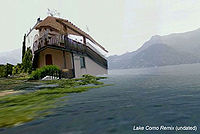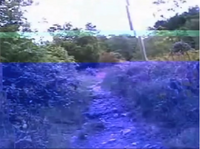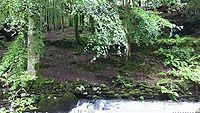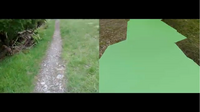Artist 2.0
The Artist 2.0 and the Museum of Glitch Aesthetics are, respectively, character and context in the transmedia narrative directed by Mark Amerika. The Artist 2.0 is a "living fiction role-playing itself as a digital flux persona" legitimized through the Museum of Glitch Aesthetics, where both artist and museum inform each other as they are inextricably linked.[1]
| Lake Como Remix | |
|---|---|

| |
| Artist | Artist 2.0 |
| Medium | Digital Video |
| Date | unknown |
| URL | http://glitchmuseum.com/lakecomoremix.html |
The Artist 2.0 Persona
Through the Museum of Glitch Aesthetics, the fictional lifeline and evolving art practice of the Artist 2.0 is simultaneously created and presented to viewers, in such a way, that language and institutional formatting lend anonymity and pseudo-legitimacy to the artist.[2] As such, the Artist 2.0 brings focus to the value-producing forces in art making; curators, art historians, media critics, and directors, thus acting as a social investigation of the way humans facilitate information streams, through social media culture, in constructing their online "net" identities.[3][4] Ultimately though, "'the Artist 2.0' persona was created to indicate how an emerging form of art making associated with social media practices and an emerging new aesthetic are simultaneously challenging conventional art world exhibition contexts as well as embedding themselves in the art historical canon."[5]
Aesthetics
The Artist 2.0 facilitates the glitch aesthetic, that is, new media technology employed in the posthumous production and manipulation of data. The Artist 2.0 uses information technology and network-mediated art production that spans across a diverse collection of practices in art making. Such forms includes digital photography, animation, Net art, digital video, live performance, installation, electronic music and spoken word art, mobile phone films, 3D game design, and conceptual writing.[6] Such types and processes of data manipulation lend to the deconstructive and reconstructive aesthetic duality of the Artist 2.0, where data is found and captured, and then reconstructed to propagate meaning through the process of its deconstruction and manipulation. It is this glitch aesthetic that produces theme and critical social dialogue from the developing perspective of new media technology and data.
Conceptual History
The Early Years
| The Early Years: Pixelmash | |
|---|---|
| Artist | The Artist 2.0 |
| Medium | Digital video projection |
| Date | 2005 |
| URL | http://www.glitchmuseum.com/pixelmash.html |
The Early Years is the first phase of The Artist 2.0's work. Beginning in 2005, the first documented piece to exemplify his glitch aesthetic was Pixelmash. Displayed as a digital video projection in the Winter Gardens building in Morecambe, United Kingdom, Pixelmash was part of an exhibition by local artists in the Net art scene.[7] This installation was captured on an early mobile phone, resulting in a poor quality video. The documentation by mobile phone again appears in his .gif(t) economy series, in which he appropriates images from a variety of sources such as film, painting, and pre-existing images on the internet. The glitchy images and stills were created into short, quick animated GIFs, and distributed online. The Artist 2.0 plays with language and electronic forms of literature in Verse Versus Versions (2005). The most pivotal part of The Artist 2.0's early years is the collection of his work on a Blogger website. Here he displayed the digital images of which he modified the binary data to create glitch effects.[8] Upon entering art school, the blog progressed into a virtual museum exhibiting his body of work, and it was aptly was renamed Glitch Aesthetics.
Art School Studies
In this period, during which "historians believe that The Artist 2.0 ... went to school in the Northwest of England, perhaps at the University of Lancaster,"[9] he was influenced by the natural and built environment. This led to an increasingly performative practice. Despite being inspired by the environment around the artist, the work is not tied to physical or specific space. The medium of mobile phone video, used for Mobile Beach, Mobile Conduction, Power, and Deep Interior Landscape, while recording a physical space, comes across as a rejection of specific physicality. The Glitch Aesthetics Blog, a piece which exists only online and which features entirely computer-produced images, further removes the significance of physical space. In his subsequent work, the artist continues to explore this tension between the relationship between an emotional connection to physical space and the spatially non-specific nature of digital experience.
Lake District Walks
| Lake District Walks: Code Mosh | |
|---|---|

| |
| Artist | The Artist 2.0 |
| Medium | Footage from Nokia N93 |
| Date | 2007-2008 |
| URL | http://www.glitchmuseum.com/ldw1.html |
Of the many Lake District Walks video series, the Museum of Glitch Aesthetics has collected three works where, The Artist 2.0 explores different approaches centralizing his experience in the isolated location: Lake District of England.[10] The Artist 2.0’s, Lake District Walks, videos show an exploration of adventurous hikes in this reclusive area while depicting a variety of experiences through the intentional layers of glitch effects post produced after the raw “walkthrough” footage. Lake District Walks focuses on “nature of technology and the technological apprehension of nature as an image”. [11] The Artist 2.0 obstructs this relationship between nature, technology and the sublime.[12]
Google-Assisted Living
Google-Assisted Living consists of the three titles: Cinecriture, Lake Como Remix and, 8-Bit Heaven. What makes these works different from the rest is that it was created using Google Earth and Google Street Viewing Software. It is said that this particular series is The Artist’s 2.0’s “digital lifestyle practice and “as derivative of content already explored by Situationists.”[13] The Artist 2.0 plays with the glitch aesthetics provided by Google Street View and Earth which The Artist 2.0 believes is challenging the “false representations of high-definition.”[14] This Google-assisted view of landscape is reminiscent of his handheld phone video art Mobile Conduction, in which was the experimentation with handheld videography, but now taken further to expose glitches and abstract forms of pixelated scenery. 8-bit Heaven was released as part of an April Fool’s Day joke that eventually became serious art[15] which allowed The Artist 2.0 to expand aesthetic investigations into landscapes and city life.
HD Streaming
| The Flow of Data Captured in an Idyllic Scene | |
|---|---|

| |
| Artist | Artist 2.0 |
| Medium | High Definition Video |
| Date | unknown |
| URL | http://glitchmuseum.com/theflowofdatacaptured.html |
HD Streaming is a four part HD video series; Falls from Grace, The Flow of Data Captured in an Idyllic Scene, More Data Under the Bridge, The Water of Information, depicting natural settings being captured and streamed through the digital lens, or rather, they capture the effect of digitization. Locations greatly vary across the globe, and dates unknown.
HD Streaming is in effect, a play on words where streaming is defined as the act of streaming video, yet is closely referenced to the noun stream, flowing water. Thus, it follows that we see in this series, a localized datamoshing, or "glitching" effect, focused in and around, but not restricted to, the areas where there is flowing water, as a means to create meaning between the ideas of flowing water and flowing data[16] Conceptually, through HD Streaming, Artist 2.0 is simultaneously referencing and investigating the problematic effect of the digital lens on social experience and our complex relation to technology. The interplay between the meanings of streaming expresses the digitization of nature, the normalizing effect that media sharing on the net over time has had on perceptions. Through this socially perpetual normalizing behaviour, Artist 2.0 means to address the concern of blurred boundaries between the perception of natural and the perception of artificial, that is; data, pixels, and byte artifacts.
In reference to the series, Artist 2.0 touches on the personal influences and themes involved:
"When I see a beautiful scene in front of me, I almost can't believe it. I want to immerse myself in it the way I would a novel or film. But to interrupt my gaga eyes with the purely technical need to capture these environments as streaming images that I then feel compelled to share with my distributed network -- that's when my relationship to nature, to what is seen, becomes problematized. It becomes less about what the artist sees per se and more about what it means to see the way digital devices see, and to respond to ones surroundings with a supplementary machinic vision connected to the network of others I am sharing my life with. Sometimes I call these works 'Site Unseen'."[17]
The Comedy of Errors
The Comedy of Errors is an "album length work of comedic sound art."[18] Of Artist 2.0's artworks, this piece is the least conceptually related to the others. It displays "glitch aesthetics" but it has no visual component, and does not deal directly with notions of physical space, which is a common theme in Artist 2.0's other work. This piece is more closely related to the artwork that the Artist 2.0 mythology makes up than to the meta-artwork attributed to Artist 2.0. This is shown clearly near the beginning of the recording, when the comedian says "No no really, don't commit me — that's the siren song of every avant garde artist ... let's face it, nobody wants to be institutionalized. Whether it's work, school, or prison, the bottom line is always the same: get me the fuck outta here!" In terms of conceptual history, The Comedy of Errors does not relate to Artist 2.0's works, but it can be seen as a precursor to the overall Artist 2.0 project.
Later Works
| Getting Lost (The Long Dérive) | |
|---|---|

| |
| Artist | Artist 2.0 |
| Medium | digital video and 3D animation (two channel) |
| Date | 2012 |
| URL | http://www.glitchmuseum.com/gettinglost.html |
Artist 2.0's 'Later Works', both from 2012, are Getting Lost (The Long Dérive) and WeRMediumzGoMetaOn-U. These two pieces continue earlier explorations of Artist 2.0's; Getting Lost is a new take on the Lake District Walk, and WeRMediumzGoMetaOn-U appears to be "associated with both the Google-Assisted Living series and some of the earlier experiments with both mobile videography and experimental forms of text."[19]
These works are also both remixes. Getting Lost remixes Artist 2.0's own video with new imagery created with a 3D game engine.[19] WeRMediumzGoMetaOn-U is a "remixological inhabitation of the last twelve minutes of [Chris] Marker's La Jetée."[20]
These 'Later Works' examine the way we experience digital media and digital space through analogy to physical space. According to the Catalogue, Getting Lost presents the artist as a "virtual flanéur who traverses the experimentally rendered 3D game environment" [21], and WeRMediumzGoMetaOn-U depicts a 'network of artist-mediums ... searching for a more dispersed, out of body and autohallucinatory revalation.[22] Digital technology presents new forms of experience which are, even at their most recognizable, fundamentally from any previous human experience. Artist 2.0's later works point out that as we begin to experiment with new experiences, we naturally relate to them and discuss them through analogy to familiar experiences; in this case, we relate the digital to the physical. Nevertheless, a complex give-and-take is soon established; increasingly, we begin to expect digital experience to offer a "higher realm of experience ... [that] is idyllic, utopian, and oftentimes over-aestheticized" and imagine our idealistic utopias as involving digital experience.[23]
To some extent this is all nonsense; however, when presented both with the Artist 2.0's artwork and the surrounding theorization that creates Artist 2.0's mythology, we are forced to theorize ourselves about the effects of both. Thus, the conceptual impact of the work is to force the viewer to consider the concept of the meta-artwork, how its validity is effected by its status as a meta-artwork, and how these maps analogously onto digital/physical experiences and art world structures that are less contrived.
List of Artworks
- The Early Years
- Verses Versus Versions
- Pixelmash
- .gif(t) economy series
- Art School Studies
- Glitch Aesthetics Blog
- Mobile Beach
- Mobile Conduction
- Power
- Deep Interior Landscape
- Lake District Walks
- Augmented Video Reality
- Code Mosh
- Raw Source
- Glitch Lake
- Google-Assisted Living
- Cinecriture
- Lake Como Remix
- 8-Bit Heaven
- HD Streaming
- Falls from Grace
- The Flow of Data Captured in an Idyllic Scene
- More Data Under the Bridge
- The Water of Information
- The Comedy of Errors
- The Comedy of Errors
- Later Works
- Getting Lost
- WeRMediumzGoMetaOn-U
Notes
- ↑ Museum of Glitch Aesthetics Catalog, 1
- ↑ http://elmcip.net/critical-writing/artists-personas-mediums-instruments-envisioning-visionary
- ↑ http://a2ru.org/knowledgebase/museum-glitch-aesthetics/
- ↑ http://thecreatorsproject.vice.com/blog/mark-amerika-discusses-corrupting-lake-como-museum-of-glitch-art
- ↑ MOGA Catalog, 1
- ↑ MOGA Catalog, 2
- ↑ "MOGA Catalog", 4
- ↑ "MOGA Catalog," 5
- ↑ "Art School Studies." MOGA. N.p, n.d. Web. http://glitchmuseum.com/artschoolstudies.html
- ↑ http://www.glitchmuseum.com/lakedistrictwalks.html
- ↑ MOGA Catalog, 6
- ↑ http://www.glitchmuseum.com/lakedistrictwalks.html
- ↑ MOGA Catalog, 7
- ↑ http://thecreatorsproject.vice.com/blog/mark-amerika-discusses-corrupting-lake-como-museum-of-glitch-art
- ↑ http://thecreatorsproject.vice.com/blog/mark-amerika-discusses-corrupting-lake-como-museum-of-glitch-art
- ↑ MOGA Catalog, 07
- ↑ http://professorvj.blogspot.ca/2012/08/the-conceptual-artist-20.html
- ↑ "The Comedy of Errors." MOGA'. N.p., n.d. Web. 'http://glitchmuseum.com/thecomedyoferrors.html
- ↑ 19.0 19.1 "Later Works." MOGA. N.p., n.d. Web. http://glitchmuseum.com/laterworks.html
- ↑ "MarkerAmerique in Paris and Honolulu." Professor VJ. N.p., 26 November 2013. Web. http://professorvj.blogspot.ca/2013/11/markeramerique-in-paris-and-honolulu.html
- ↑ MOGA Catalog, 16
- ↑ MOGA Catalog, 17
- ↑ MOGA Catalog, 17
References
Museum of Glitch Aesthetics Catalog. Ed. Mark Amerika. Self-published, 2012. PDF.